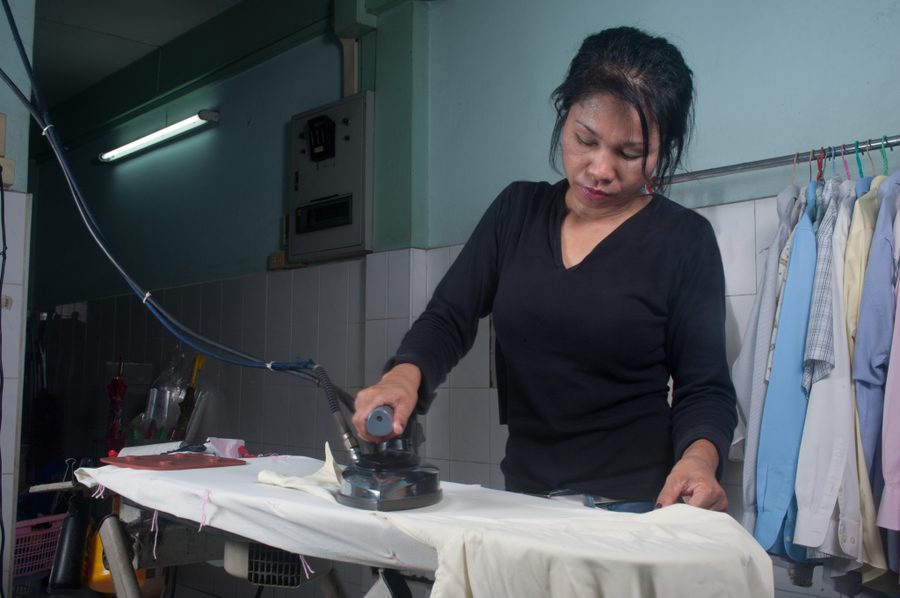A Direct Legacy of Slavery, Domestic Worker Exploitation Is On the Rise In the U.S.
The pandemic has left already vulnerable workers even more exposed to abuses on the job.
Maurizio Guerrero

Gloria’s job as a domestic worker was hard enough before the pandemic hit.
“We were forced to clean the floors on our knees. It made me feel humiliated,” says Gloria, a 36-year-old Ecuadorian immigrant who arrived six years ago in New York, where she works as a housecleaner. (Gloria is undocumented; In These Times is using a pseudonym to protect her identity.) “The economic needs have forced me to perform a job that I was not expecting to find here.“
Gloria eventually refused to kneel down to clean the floors, despite her fear of being sacked from the job and the language barriers. Now, the pandemic has imposed another burden on domestic day laborers like her. Domestic workers and their advocates say that the Covid crisis has caused wages to drop and work to dry up, and has left already vulnerable workers even more exposed to exploitation.
The pandemic caused an immediate dip in Gloria’s pay. With work even more precarious than before, she was forced to accept lower wages. After earning $13 or $14 per hour before Covid hit, Gloria says, “we have to work now for meager wages, for $10, $11, $12 per hour, even though our job is tough and considered essential.“
Gloria usually works for Hasidic Jewish families in Brooklyn, some of whom refused to wear protective equipment in her presence, at least during the beginning of the pandemic. She did not receive protective gear herself.
As a day laborer in New York, Gloria has no legal recourse to denounce abuses. She is far from alone: unlike other workers who, regardless of immigration status, are protected by federal and state laws, the vast majority of America’s 2.5 million domestic workers are explicitly left out of these protections.
“Domestic workers live in the legacy of slavery, and this legacy continues to shape the sector today,” said Allison Julien, co-director of the New York Chapter of We Dream in Black and a founding member of the National Domestic Workers Alliance (NDWA), during an August 13 video-conference to commemorate Black Women’s Equal Pay Day.
“Government leaders deliberately carved out domestic and farmworkers” from any law that could protect their rights, Julien added.
Domestic workers were excluded from the National Labor Relations Act, the Occupational Safety and Health Act and the Fair Labor Standards Act because Southern senators refused to grant equal protection to a workforce made up largely of black women. That legacy is alive and well today.
Domestic workers are entitled to the federal minimum wage of $7.25 an hour, but they do not have the right to form unions and are not covered by federal anti-discrimination laws. Employers are not obligated to provide safe working conditions or protective gear for workers.
Nine states and the city of Seattle have versions of a “domestic workers’ bill of rights,” although most of them lack enforceable frameworks, according to Polaris, a nonprofit that operates a national human trafficking hotline, conducts research and promotes policy changes.
New York has a domestic worker law, but people who work less than 40 hours a week cannot access its benefits. Day laborers like Gloria, who are hired by the day or by the hour, are similarly excluded from the law’s benefits, as are undocumented people.
Black and undocumented domestic workers have been disproportionately affected by these exclusions, compounded by the current health emergency and the resulting economic recession.
A survey conducted in May and June in Massachusetts, Miami-Dade County, and New York by the Institute for Policy Studies and NDWA found that, in the wake of the crisis, 70% of the Black immigrant domestic workers surveyed had either lost their jobs (45%) or received reduced hours and pay (25%). Black undocumented workers were nearly twice as likely to be terminated than documented workers (64% compared to 35%).
Domestic workers’ plight can be seen every morning on the corner in Williamsburg, Brooklyn, where dozens of them gather to get a job for the day. “It’s a little vignette of the reality women migrant workers face in this country,” says Ligia Guallpa, co-executive director of the Worker’s Justice Project (WJP), a grassroots organization.
Before the pandemic, 40 to 50 women laborers showed up every morning. Now, Guallpa says, that number has climbed to between 70 and 80. “You can imagine that employers now have a bigger advantage. They know that the need is greater for workers,” she says.“Apart from competing for work with 80 other laborers, these women are now forced to accept whatever the employer offers –$10 or $8 per hour.“
Trafficking goes up
The vast majority of domestic workers are immigrants, which makes them particularly vulnerable to exploitation and labor trafficking –when employees are forced to remain on the job through threats, violence or other forms of coercion, or brought to a country through fraudulent means.
Andrea Rojas, director of Strategic Initiatives at Polaris, says that this is a form of modern-day slavery. This situation, she adds, “sends the very dangerous message that since these workers have been excluded from protections granted to other work categories, they are less valuable.“
Polaris registered 8,000 labor trafficking cases in the U.S. from 2007 to 2017, the highest number of which involved domestic work. The pandemic has coincided with a spike in referrals to the organization.
The number of trafficking cases (both from sex and labor trafficking) handled by the Polaris hotline increased by more than 40% in the month after the lockdowns in the U.S. compared to the prior month – from approximately 60 to 90.
New York state has experienced a similar trend. The New York State Trafficking Victim Referral Process processed 177 referrals between January and June, a 70% increase over the same period in 2019.
Domestic workers have often been left to their own devices and the mercy of employers.
“We are talking about foreign workers who often do not know the language, who are isolated and without their safety networks,” Rojas explains. There’s also a power imbalance, she adds, when low-paid laborers work in wealthy people’s houses.
Even workers who arrive in the U.S. with visas as nannies or au pairs receive a “know-your-rights” brochure that makes them responsible if they become labor trafficking victims, according to Polaris.
Without legal protections, civil society groups and international organizations have launched initiatives to reduce domestic labor exploitation. Polaris and the NDWApromote a code of conduct for employers and a program to train anyone who hires a foreign domestic worker for the first time.
The WJP offers employers the chance to hire domestic workers under secure conditions for both parties. According to Guallpa, the conditions include a $20 per hour minimum wage and a requirement that employers give their workers protective equipment.
Without these programs, and the generosity of some employers, Gloria says she would not be able to navigate the current crisis.
“We pay our taxes but have been excluded from all government aid,” she says. “We have to keep on risking our lives for very little money.”
Maurizio Guerrero is a journalist based in New York City. He covers migration, social justice movements and Latin America.








